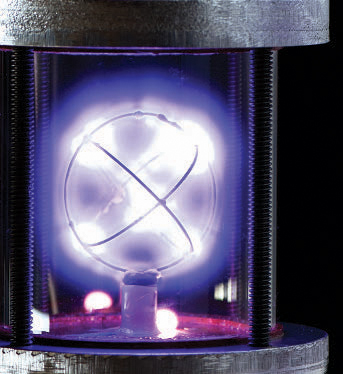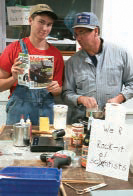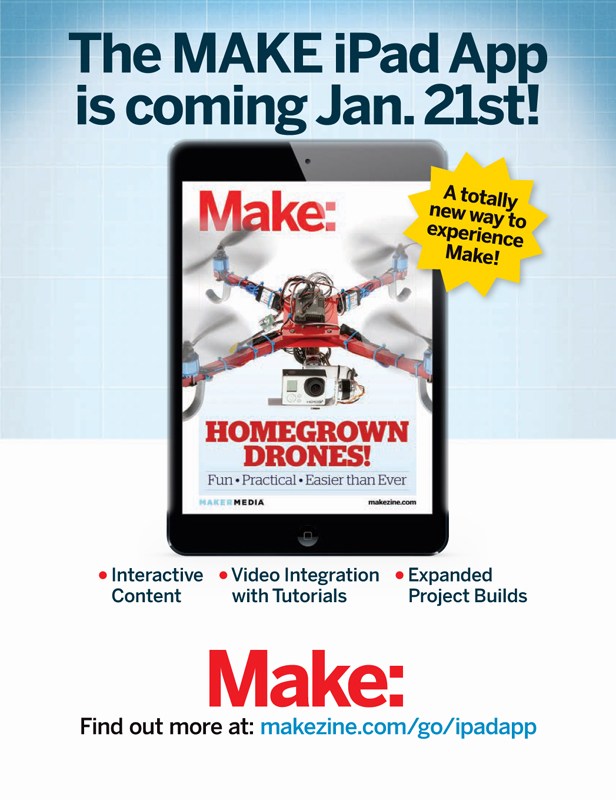READER INPUT
Nuclear Fusors, Homemade Sugar Rockets, Hard Cider, and 3D Printing Raves

» I CONTINUE TO BE AMAZED AND DELIGHTED WITH MAKE. I have to commend your contributors for their ingenuity and practicality. In the latest issue (Volume 36) I was especially fascinated by the Nuclear Fusor project by Dan Spangler — well written, clear, and concise. I do, though, have to take issue with his statement on page 93 regarding Philo Farnsworth. John Baird transmitted the first televised pictures of moving objects in 1924, the first televised human face in 1925, and the first real-time moving object in 1926. But it was electronics inventor Farnsworth who is credited with inventing the first completely electronic television. So to clarify, it was Baird who invented television and Farnsworth who invented the first fully electronic television.
Your magazine really inspires me up from my seat to get involved and make things. I wish it would be more widely available in the U.K., as I’m sure it would inspire many young inventors and engineers. With this thought, I will be donating a yearly subscription to my old school.
—Christopher Glasgow, Byfleet, Surrey, U.K.

» Earlier this month my son Tucker and I followed William Gurstelle’s instructions to build the Homemade Sugar Rockets featured in MAKE Volume 35 (page 70). We failed, learned, failed some more, learned some more, and through persistence had great success and improved the recipe to our liking, and hopefully to yours, too. I hope the following notes on the process will help you with this fast, easy, and super-fun project.
—Wayne Arendsee, Fort Worth, Texas
+ Read Wayne's tips and tricks at makezine.com/fatherson/.
» Thanks for the great tutorial (Volume 36, page 132, “Kitchen-Table Cider Making”). My notes from one batch of apple cider and two batches of pear:
First, the filtration bag gets heavy. I made the apple cider without the bucket with holes and the bag slipped off the larger bucket and fell in, causing me to have to strain everything again. Second, my brewing bag gets clogged up pretty fast. Strains really well, but requires a lot of squeezing at the end to get all the juice out. Third, the bottled cider flavor really reflects what you put into it. The apples, for example, were tarter than my pears. Fourth, the sugar added beautiful little bubbles. Haven’t sampled the non-sugared bottles, yet.
Without the suggestion of using a juicer, I might not have made any cider this year. But your instructions provide a clear and easy path for a first-timer. Well done.
—Matt Friedrichs, via the web
» I gotta admit, I’ve really been enjoying these practical examples of 3D printing that you guys have been kicking out lately (Make: Ultimate Guide to 3D Printing 2014, page 14, “10 Cool 3D Printed Objects,”). We’ve seen years of 3D printers kicking out the same Yoda heads. I’ve frankly been rather skeptical about the “3D Printing Revolution” that’s been prophesized, and still am somewhat, but these posts are changing my thinking bit by bit.
—Andy Tanguay, Ann Arbor, Mich.
IN RESPONSE TO THE B9 CREATOR REVIEW IN THE MAKE: ULTIMATE GUIDE TO 3D PRINTING 2014 (PAGE 93):
» I own a B9 and have been absolutely blown away by the detail it is able to produce. I use it for my business as a product designer and for making N-scale model trains — where it is able to match (yes, match) the detail of injection-molded parts. I had about 15 prints where I made various mistakes but now it pretty much works every time, and Mike Joyce [the founder] has personally helped me to overcome issues along the way — as he has for almost everyone who has bought one of these machines. I have no affiliation to Mike or B9, except as a very, very satisfied customer. If you want small parts with exquisite detail (jewelers, small scale modelers, small product prototypes), then this is the machine for you.
— Robert Fryers, via the web
» It’s worth stressing that this entire project has been open sourced by Joyce. I built my own printer, loosely based on his designs and using his software, and he was incredibly helpful as I was feeling my way through. A very generous maker, with a very cool product!
—William Fredette, Worcester, N.Y.
MAKE AMENDS: In MAKE Volume 36’s Country Scientist column, “How to Use LEDs to Detect Light,” in the schematic in Figure D (page 138) the LED should be reversed, with the anode connected to ground and the cathode connected to IC1-2. Thanks to intrepid reader Rob Kuschinsky for pointing this out.

